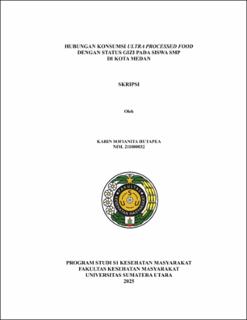Hubungan Konsumsi Ultra Processed Food dengan Status Gizi pada Siswa SMP di Kota Medan
The Relationship Between Ultra-Processed Food Consumption and Nutritional Status Among Junior High School Students in Medan City

Date
2025Author
Hutapea, Karin Sofianita
Advisor(s)
Situmorang, Risanti Febrine Ropita
Metadata
Show full item recordAbstract
Energy and nutrient requirements in adolescence are needed to support the growth and development of the body. However, adolescent diets are characterized by low intake of fruits and vegetables, and high consumption of unhealthy (low nutrient) foods such as ultra processed foods (UPF). Teenagers tend to choose foods that they like without paying attention to their nutritional content or health. UPF contains a lot of refined sugar, bad fats, and additives that can cause insulin resistance and obesity. This study aimed to determine the relationship between UPF consumption and nutritional status in junior high school students in Medan City. The research design use was cross sectional with Proportional Random Sampling technique. The study population was students in grades VII and VIII in six public junior high schools spread across six sub-districts in Medan City with a total of 3,733 students. The number of samples in this study was 101 people. UPF consumption data was obtained using Food Frequency Questionnaire (FFQ), and nutritional status was calculated based on Body Mass Index by Age (IMT/U) using WHO AnthroPlus. Data were analyze using the Spearman Rank correlation test. The results showed a significant relationship between UPF consumption and students' nutritional status (p<0.05). It is recommended for schools to collaborate with Puskesmas and the Health Office to provide education on the impact of UPF consumption and the risk of overnutrition, and students are expected to limit UPF consumption, especially for those with overnutrition and obesity status.
Collections
- Undergraduate Theses [3360]
